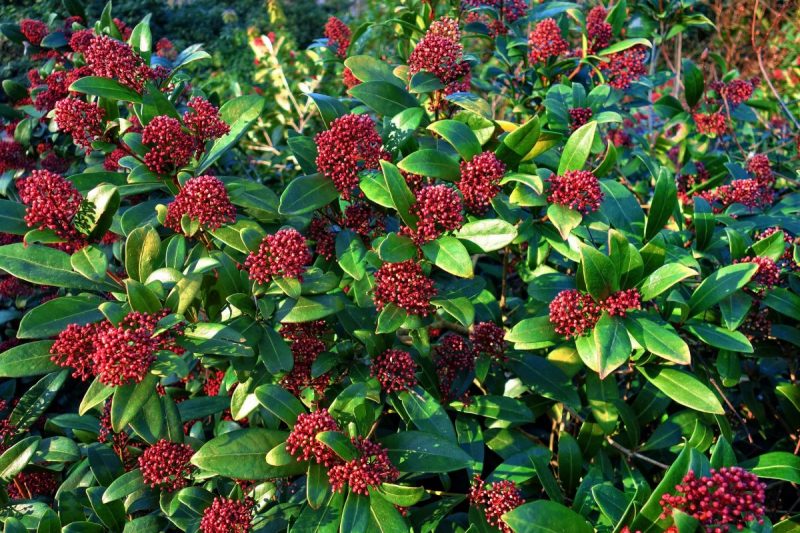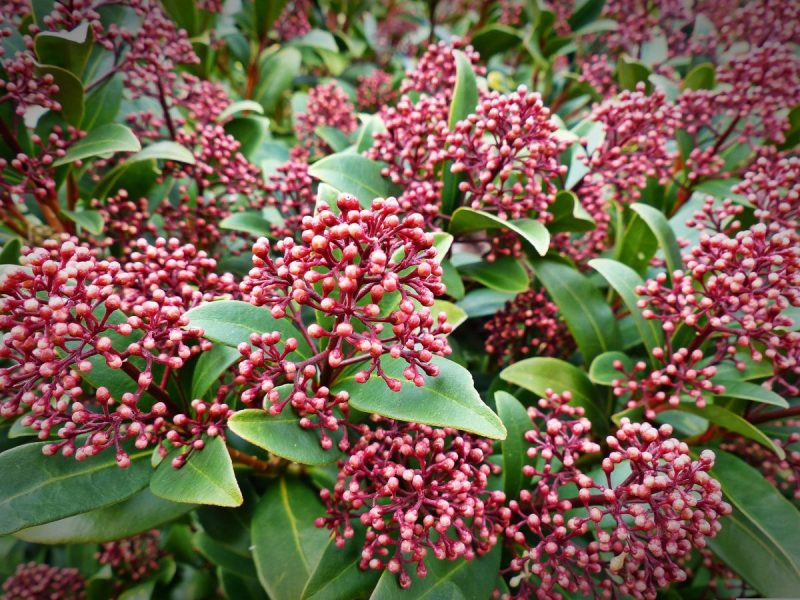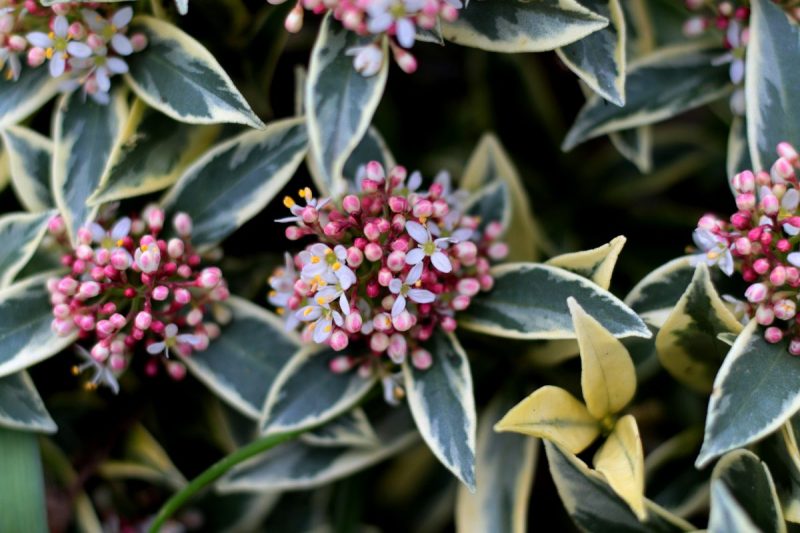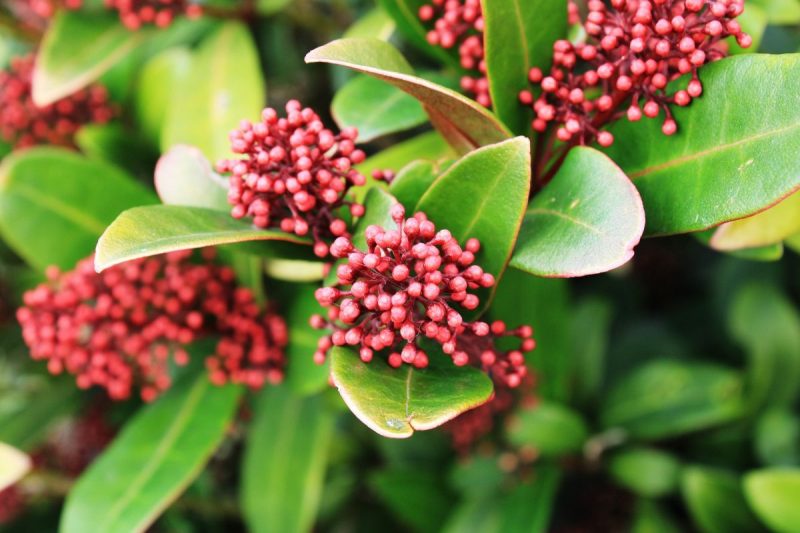Japanese skimmia, planting guide and care work

Skimmia (Skimmia japonica) commonly named ‘Japanese skimmia’, is an ornamental shrub with persistent leaves, native to Japan, China and Southeast Asia. Japanese Skimmia has a slow growth, but it can reach a height of up to 1.5 m. It stands out for its rich, evergreen, dark-colored foliage and fragrant, white flowers. It is a unisexual dioecious plant, there are specimens with female flowers and others with male flowers. The fruits are spherical, variously colored, very decorative. To produce fruit, it is recommended to plant a specimen with female flowers and one with male flowers nearby, in order to achieve pollination. The flowers appear in the spring-summer period.
Skimmia is mainly found outside, in gardens, parks, but it can also be grown in flowerpots and containers.
Japanese skimmia – cultivars
- Skimmia japonica ‘White Globe’: it is a cultivar with male flowers, compact, with glossy green leaves. It bears white, fragrant flowers that bloom from very decorative, light green buds;
- Skimmia japonica ‘Rubella’: a cultivar with male flowers, very decorative with red buds that form white flowers in spring;
- Skimmia japonica ‘Temptation’: it is a self-fertile, compact shrub with elliptical leaves and dark red buds. The flowers are small, white and form red fruits;
- Skimmia japonica ‘Veitchii’: it is a cultivar with female flowers, vigorous, which bears oval to lanceolate, dark green leaves. The panicles are dense, composed of white, fragrant flowers that appear in spring. The fruits are large, round, red in color.



Environmental conditions
Light. It is a shade-loving shrub and can be placed in partially or completely shaded places. It can also grow in bright places, but not in direct sunlight. The strong sun leads to the discoloration of the leaves and the appearance of burns.
Temperature. It tolerates temperatures of up to – 15 ℃ during the cold season. It can also withstand high temperatures during the summer, if it is placed in more shaded areas.
Sol. Japanese Skimmia grows and develops well on fertile and well-drained soils. It prefers a soil with a slightly acidic pH.
Japanese Skimmia – care
Watering. It can be carried out moderately, but regularly, so that the soil remains damp. Japanese Skimmia does not tolerate long periods of drought. It is important that the watering is carried out at the base of the plants, so that the foliage remains dry.
Fertilizing. Periodic fertilizing encourages the appearance of new growths and the normal development of the shrub. You can use a fertilizer specially formulated for decorative shrubs.
Recommended products
-
You can find products on a different store
Change Store -
You can find products on a different store
Change Store -
You can find products on a different store
Change Store -
You can find products on a different store
Change Store -
You can find products on a different store
Change Store -
You can find products on a different store
Change Store -
You can find products on a different store
Change Store -
You can find products on a different store
Change Store -
You can find products on a different store
Change Store -
You can find products on a different store
Change Store -
You can find products on a different store
Change Store -
You can find products on a different store
Change Store -
You can find products on a different store
Change Store -
You can find products on a different store
Change Store -
You can find products on a different store
Change Store -
You can find products on a different store
Change Store -
You can find products on a different store
Change Store -
You can find products on a different store
Change Store -
You can find products on a different store
Change Store -
You can find products on a different store
Change Store -
You can find products on a different store
Change Store -
You can find products on a different store
Change Store -
You can find products on a different store
Change Store -
You can find products on a different store
Change Store
Pruning. It does not need drastic pruning, having a more compact shape by itself. Dry, damaged or wrongly grown branches can still be removed. Pruning can be carried out during the dormancy period .
Recommended products
-
You can find products on a different store
Change Store -
You can find products on a different store
Change Store -
You can find products on a different store
Change Store -
You can find products on a different store
Change Store -
You can find products on a different store
Change Store -
You can find products on a different store
Change Store -
You can find products on a different store
Change Store -
You can find products on a different store
Change Store -
You can find products on a different store
Change Store -
You can find products on a different store
Change Store -
You can find products on a different store
Change Store -
You can find products on a different store
Change Store -
You can find products on a different store
Change Store -
You can find products on a different store
Change Store -
You can find products on a different store
Change Store -
You can find products on a different store
Change Store -
You can find products on a different store
Change Store -
You can find products on a different store
Change Store -
You can find products on a different store
Change Store -
You can find products on a different store
Change Store -
You can find products on a different store
Change Store -
You can find products on a different store
Change Store -
You can find products on a different store
Change Store -
You can find products on a different store
Change Store
Propagation. It is propagated by semi-lignified cuttings, harvested at the end of summer or at the beginning of autumn. It can also be propagated by seeds, but the development into adult plants requires a longer time.
Diseases and pests
It is rarely affected by diseases or attacked by pests. However, Scale bugs or mites may occasionally appear.
Additionally:
- Yellowing of the leaves can be a sign that the plant has been exposed to strong sunlight. Also, this symptom can also be caused by the pH of the soil; an alkaline pH prevents the absorption of nutrients from the soil/substrate;
- Skimmia can also be cultivated in pots, but it is important that the watering is done regularly, so that the substrate does not dry out completely before watering again;
- All parts of the plant are toxic.















































































































































































































































































































































































































































